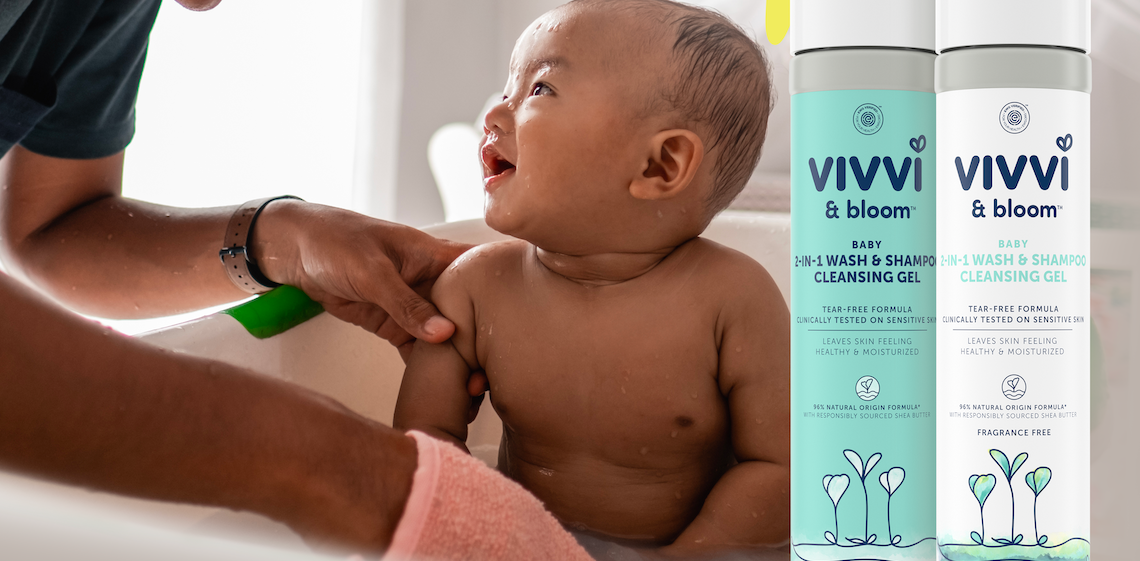More than 20 years after Johnson & Johnson expanded Aveeno into baby care and more than 128 years after the creation of Johnson’s Baby, the consumer health conglomerate is launching a new baby care brand.
Launched on Wednesday, J&J’s Vivvi & Bloom is meant to address the modern values of Gen-Z and millennial parents and caregivers. It’s community-led and offers more natural formulas, inspired by beauty industry trends that have taken off in the last decade. Vivvi & Bloom launched with five products, including shampoo, body lotion and a scalp and body oil, all for around $10. The brand will sell through Walmart, Amazon.com and various drugstore chains. All products were formulated without parabens, sulfates and dyes, and were verified by the Environmental Working Group, which has actively promoted clean beauty. Vivvi & Bloom was also developed with a community of 238 diverse millennial and Gen-Z parents and caregivers who provided feedback during brand development.
“This is a different approach for Johnson & Johnson, in terms of bringing in a community from the start and co-creating the digital-first [approach],” said Duda Kertész, president of U.S. skin health for Johnson & Johnson. “Those are approaches that we want to learn from and potentially leverage in other parts of our portfolio.”
Vivvi & Bloom is also a premium brand, compared to Johnson’s Baby and Aveeno Baby. A 10-ounce bottle of Vivvi & Bloom baby wash and shampoo is $9.98 at Walmart, compared to larger sizes of Johnson’s Baby shampoo at $4.28 and Aveeno Baby shampoo at $6.76. Luxury beauty brands, such as Chantecaille, Dr. Barbara Sturm and Aurelia, have taken to developing premium and luxury versions of baby-care lines since 2019. Beauty company Amyris Inc., which owns skin-care brand Biossance, has also acquired baby-care brand Pipette as a means to grow its portfolio and serve both parents and their children.
Clean beauty, in part, originated out of concerns around fertility and motherhood and the products moms-to-be use, and many beauty brand founders have credited becoming pregnant as the launch point for their switch to clean products.
Kertész noted that Johnson’s Baby and Aveeno Baby feature many of the same claims and product development features of Vivvi & Bloom, such as being formulated without parabens and sulfates, though they’re not recognized for those selling points. In 2018, Johnson’s Baby redesigned its entire product line, cutting out chemical dyes and adding more ingredients found in nature like coconut oil. As WSJ reported at the time, parents viewed Johnson’s Baby as “old-fashioned and chemical-laden.” The relationship with Johnson’s Baby Powder and the class action lawsuit alleging that it caused cancer likely had not helped that reputation. Johnson’s Baby has 10.5% of the global market share across the entire baby care category and holds the No. 1 position in U.S. baby skin care and No. 2 position in U.S. baby hair care, after L’Oréal Kids, according to 2021 data from Euromonitor.
“We want to have the No. 1, No. 2 and No. 3 brands in the baby care category. We want Vivvi & Bloom to rise to the top,” said Kertész. “Hopefully, it will drive category growth and bring more parents to try these products and stay longer [in the baby care category]. Sometimes parents move into adult products as their babies grow into toddlers and kids because they don’t feel the products serve their needs.”
Ad position: web_incontent_pos1
Johnson & Johnson reported its second quarter 2022 earnings on Tuesday, wherein it saw a 1.3% decline in consumer health sales from $3.85 billion year-over-year. Its consumer health division houses beauty brands like Aveeno and Neutrogena, alongside Johnson’s Baby. On the earnings call, Joe Wolk, CFO of Johnson & Johnson, cited supply chain constraints as a primary reason for the sales decline. Kertész declined to share sales expectations for Vivvi & Bloom.
“The macro headwinds … [are] really around supply constraints, some of what we commented [on] at the end of last year that kind of persisted into the first part of this year. That was primarily in our consumer franchise, where product supply and availability inputs were somewhat constrained. We are seeing an alleviation of some of those constraints, and that’s why we anticipate, specifically in our skin health and beauty business, to be much stronger in the second half [of the year],” Wolk said.
As part of its digital-first approach, the brand recruited 2,000 millennial and Gen-Z parents and caregivers through a third-party partner for consumer research, before winnowing the group down to 238 who represent the co-creation community. Referred to as “The Village,” these people weighed in on product development, brand values and even which charitable organization to partner with. Newborns in Need, a nonprofit, is the resulting benefactor.
To kick off the launch of Vivvi & Bloom, the brand hosted a press and influencer event on Wednesday for influencer parents and the co-creation community at the Queens Botanical Garden in New York City. The co-creation community will also create digital content and act as spokespeople by featuring Vivvi & Bloom in communications. Johnson & Johnson declined to share whether anyone in the community was compensated during Vivvi & Bloom’s development or will be moving forward.




